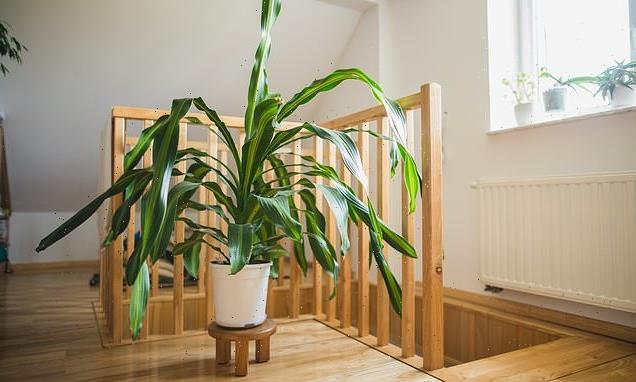Common houseplants including peace lilies and ferns can reduce air pollution in homes and offices by as much as 20%, study reveals
- Scientists tested 3 common houseplants – Peace lily, Corn plant and fern arum
- All three plants removed 50% of nitrogen dioxide (NO2) from a test chamber
- Equivalent of 3 plants removing 20% of NO2 from a small office in a polluted area
- The mechanism remains unclear, but is likely different to the way plants remove carbon dioxide from the air
Houseplants are often seen as decorative features, but if your home is full of potted plants, you may also be reducing the levels of certain pollutants.
New research led by the University of Birmingham has revealed that common houseplants can reduce levels of nitrogen dioxide (NO2) – a common pollutant – by as much as 20 per cent.
While the biological process behind the NO2 removal remains unclear, the researchers hope the findings will encourage people to fill their homes or offices with more plants.
Houseplants are often seen as decorative features, but if your home is full of potted plants, you may also be reducing air pollution. Pictured: a corn plant (Dracaena fragrans)
The psychological benefits of indoor plants
The psychological benefits of indoor plants have been shown as:
- An improved mood
- Reduced stress levels
- Increased worker productivity (adding plants to office environments in particular)
- Increased speed of reaction in a computer task
- Improved attention span (in some scientific studies, but not all)
- Increased pain tolerance (for example, where plants were used in hospital settings)
Source: RHS
In the study, which was carried out in collaboration with the Royal Horticultural Society (RHS), the team tested three common houseplants – Peace lily (Spathiphyllum wallisii), Corn plant (Dracaena fragrans) and fern arum (Zamioculcas zamiifolia).
Each plant was placed into a test chamber containing levels of NO2 similar to an office situated next to a busy road, before being monitored over a period of an hour.
The results revealed that all three plants were able to remove around half the NO2 in the chamber over the course of an hour.
This was regardless of their environment – including dark and light conditions, as well as wet or dry.
Dr Christian Pfrang, who led the study, said: ‘The plants we chose were all very different from each other, yet they all showed strikingly similar abilities to remove NO2 from the atmosphere.
‘This is very different from the way indoor plants take up CO2 in our earlier work, which is strongly dependent on environmental factors such as night time or daytime, or soil water content.’
To put the findings into context, the researchers calculated that in a poorly ventilated small office with high levels of air pollution, five houseplants would reduce NO2 levels by 20 per cent.
Meanwhile, in a larger space, the effect of three plants would be smaller, at around 3.5 per cent.
The researchers are still unclear about the mechanism behind the NO2 removal.
‘We don’t think the plants are using the same process as they do for CO2 uptake, in which the gas is absorbed through stomata – tiny holes – in the leaves,’ Dr Pfrang explained.
‘There was no indication, even during longer experiments, that our plants released the NO2 back into the atmosphere, so there is likely a biological process taking place also involving the soil the plant grows in – but we don’t yet know what that is.’
Breathing air with a high concentration of NO2 can irritate airways in the human respiratory system, and can be particularly damaging for people with respiratory diseases, such as asthma.
Asthma + Lung UK explained: ‘High levels of NO2 can irritate and inflame the lining of your airways, causing a flare-up of asthma or COPD and symptoms such as coughing and difficulty breathing.
‘Children and older people are also more likely to be affected and develop a respiratory infection and may react more to allergens (any substance that triggers an allergic reaction, such as pollen).’
HOW MUCH NO2 IS SAFE?
Nitrogen dioxide comes from vehicles, power plants, industrial emissions and off-road sources such as construction, lawn and gardening equipment.
All of these sources burn fossil fuels.
The US Environmental Protection Agency has issued guidance for safe levels of inhalation of Nitrogen Dioxide, measured in parts per billion breathed over the course of an hour.
Safe to moderate levels range from zero to 100 parts per billion per hour.
Scientific evidence links short-term NO2 exposures, ranging from 30 minutes to 24 hours, with adverse respiratory effects including airway inflammation in healthy people and increased respiratory symptoms in people with asthma.
Studies also show a connection between short-term exposure and increased emergency room visits and hospital admissions for respiratory illnesses.
Individuals who spend time on or near major roads can experience NO2 exposures considerably higher than occur away from roads.
These exposures are of particular concern for sensitive groups, such as people with lung disease including asthma, children and older adults.
Source: Read Full Article

